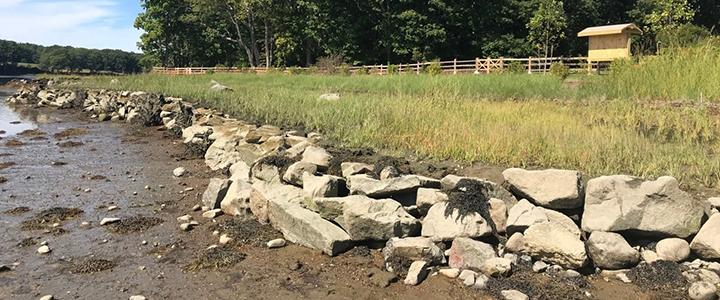
Resilient Living Shoreline Project
In 2019, the Town of Durham, in partnership with NHDES, the University of New Hampshire (UNH), and the Great Bay National Estuarine Research Reserve, finalized a design and installed a living shoreline along the tidal portion of the Oyster River at Wagon Hill Farm – the first of its kind in the state of New Hampshire. This innovative restoration project was designed specifically to reduce erosion, replace salt marsh habitat that had been lost or damaged, improve shoreline appearance, and accommodate salt marsh migration resulting from sea-level rise. Slated for spring 2020, a tour-style event to publicize the project was suspended due to the COVID-19 pandemic, and in its place a virtual walk-through is currently being prepared. This outreach is intended to engage neighboring coastal municipalities interested in implementing a similar design in their community. To learn more about the project, members of the public are encouraged to visit Wagon Hill Farm’s shoreline and view the educational kiosk, which was designed by partners at Strafford Regional Planning Commission (SRPC).
The Living Shoreline project was a long time in the making. Over 30 years ago, the Town purchased the land for what is now Wagon Hill Farm, which quickly became a favorite place to recreate amongst outdoor-loving residents and visitors. The southern 99 acres of the approximately 139-acre property is beloved for its extensive three-mile trail network that winds through fields, forests, and provides picturesque views along the shoreline of the Oyster River and Little Bay.
Since purchasing the property, shoreline erosion at rates of up to one foot per year has been an issue of concern for the Town and land stewards. A site-based Master Plan with Cavendish Partnership Inc. was developed in 1995 and concluded that shoreline stabilization was important to maintaining the frontage along the Oyster River. The Town could not fully implement long-term solutions until the bond on the property was paid off in 2009.
The erosion worsened with time, resulting in significant salt marsh and land loss at the water’s edge. As a result, the Town moved the fence along the shoreline back, which was done several times over the years, to try and guide visitor traffic away from sensitive areas. Studies, like the 2009 Stewardship plan, alerted the Town to possible causes of the erosion including waves, boat wakes, and human influences such as people and their dogs walking on the marsh shoreline.
To begin restoration of the shoreline and combat future erosion, the Town received funding from the NHDES Coastal Program in 2016. The $20,000 grant allowed the Town to partner with NHDES and UNH to monitor, assess, and design alternatives for shoreline stabilization.
Additional funding in 2017 and 2018 from NHDES’ Coastal Program and its Aquatic Resources Mitigation Fund, allowed the Town and its partners to design and install the living shoreline. Important design features included building a stone and tree root wad sill – or barrier – at the edge of the shoreline to help reduce wave energy; backfilling behind the sill to restore salt marsh area that had been lost; ensuring the upland slope was gradual enough to enable salt marsh migration; planting over 30,000 new saltmarsh plants; and installing 750 feet worth of fence to reroute foot (and paw!) traffic.
Currently, the Town and UNH have grant funds to monitor the project over the next five years to determine the suitability of the design as well as any adaptive management strategies that may be needed. In order to ensure the long-term health of the salt marsh vegetation, the Town asks those who frequent the trails to appreciate and respect the work put into protecting this special resource. This includes sticking to the specified water access point outside of the fence barrier, viewing the living shoreline from the trail or the observation platform (perfect for photos!), and refraining from walking or allowing dogs on the restored marsh surface. The success of the living shoreline at Wagon Hill depends upon thriving salt marsh vegetation.
Wagon Hill Farm is open to the public between dusk and dawn, with dogs allowed off-leash between dawn and 10 AM. Allowed uses include hiking, running, snowshoeing, cross country skiing, bicycling, and dog-walking.
Partners included the NHDES Coastal Program, the NHDES Wetlands Bureau, the UNH Coastal Habitat Restoration Team, the UNH Stormwater Center, SRPC, the National Oceanic and Atmospheric Administration (NOAA), Streamworks, PLLC., and the U.S. Army Corps of Engineers.




